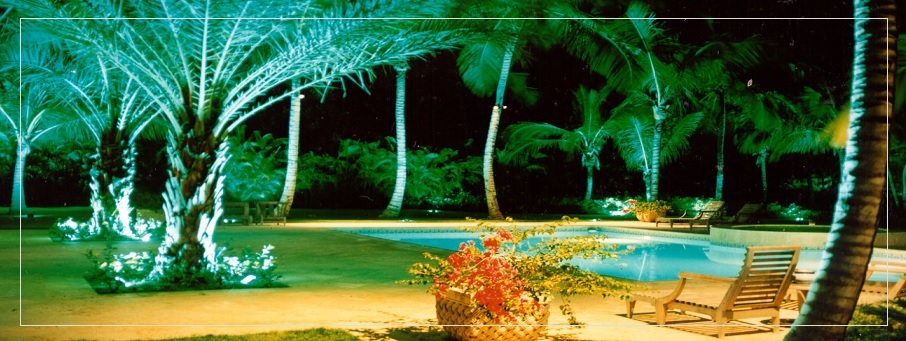How to Set-up Landscape Lighting in South Florida
You spent a lot of effort and money to make your house and yard look the way you have dreamt it to look. It would be such a pity not to be able to see their beauty at nightfall. When done right landscape lighting in South Florida will be able to highlight the architectural features of your home as well as give the spotlight to your prized plants and trees with just a flicker of a
switch.
Landscape lighting is the use of outdoor lights in your landscape. It is today common for landscape lighting to use low voltage illumination. It is safer and less expensive to use low
voltage lighting. With the use of a step-down transformer, low voltage lighting can provide your landscape with limitless effects.

Benefits of Landscape Lighting

Outdoor lighting can create an alluring landscape that everyone can enjoy during the night. It can also provide a lot of benefits.
- Provide security to the exterior of your home.
- Provide safety when walking around your landscape at night.
- Provide your visitors with a feeling of being welcome.
- Can highlight central points of your landscape while hiding eyesores.
- Can create a lively ambiance when entertaining outdoors.
Landscape lighting in short combines aesthetics and function which is important for the exterior of your home.
Types of Landscape Lighting Fixtures
There are many options for landscape lighting depending on the effects that you want to
achieve.
- Floodlights. Low-voltage or 120 volt lights use in large areas as well as large objects such as driveways, trees and stonework.
- Recessed lights. 120 volt fixtures usually installed in garages and decks. Low voltage recessed lights are for railings, light stairs and deck furniture.
- Entry lanterns. 120 volt fixtures mounted beside doors. The size of this lighting fixture should be proportionate with the width and height of the entry area.
- In-ground lights. Low voltage or 120 volt fixtures hidden in the ground. When installed at the right angle, these lights can illuminate trees, walls and fences.
- Spot lights. Highlight a particular object such as a shrub. It is similar to a floodlight but comes with a narrower beam.
- Path lights. Low voltage fixtures hurled on the ground to light paths.
- Pendant or hanging lights. These 120-v fixtures are often used for porch lighting for in entryways.
Installing these lighting fixtures at different angles and in specific areas can achieve different effects. You can work with a landscape lighting designer so you can achieve the effects that you
like.
Where to Install Landscape Lighting
- Steps and Pathways. These are the most important areas in your landscape to install lighting so you can walk around safely at night.
- Patios. Patio lighting can encourage family and friends to enjoy quiet and relaxing evenings in the patio.
- Decks. Lighting is important in this area because decks are one of the most commonly used areas in your landscape. Decks are access pathways, entertainment areas, and are also outdoor cooking areas. Lighting can also be used to surround swimming pools or hot tubs.
- Driveway. Lighting is important in this area to provide guests with a welcoming and safe entrance to your home.
- Backyard. Lighting is important in this area so the mystery and beauty of your landscape design can be enjoyed from the inside of your home.
- Swimming Pool. Lighting is important in this area mainly for safety and also to allow pool water to provide a dramatic effect.
- Ponds. Lighting is important in this area to create amazing visual effects and also for safety.
Landscape lighting can also be installed on or beside any softscape or hardscape feature to highlight the nighttime beauty of your landscape design.
How to Set-up Landscape Lighting
Landscape lighting is not just a matter of installing lights in your landscape. Your landscapelighting design should blend well with all the features of the landscape because they are meant to highlight these features. Concrete planning and installation should therefore be an important aspect of landscape lighting.
1. Identify the purpose for the need of landscape lighting. The purpose of why you want to install landscape lighting should be clear right from the very start. Your purpose will be the basis for identifying where and how the lighting fixtures are going to be installed.
2. Make a layout of your landscape. Include in your sketch all the existing features (softscapes and hardscapes) in your landscape. Each of these features will absorb or reflect light so it is important that you do not miss any of the features to ensure you come up with the right landscape lighting design.
3. Decide on the areas where to install landscape lighting. In deciding where to install landscape lighting, you should match the reason you are installing lighting fixtures to the specific areas in your landscape. If you want to enhance the look of a water fountain, you can install a spotlight in that area.
4. Set a budget. A landscape lighting designer can come up with a design based on what you want to achieve and the amount of money you are willing to spend. Landscape lighting in high-voltage can be expensive. Low voltage landscape lighting will have a lower cost. Solar lighting is the least expensive to install and operate.
5. Buy the lights and set up the landscape lighting. Lighting is one of the most important details of landscape design however it is often underdone or overlooked. Landscape lighting in South Florida is the final touch to an amazing landscape design.

